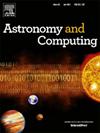BIPP: An efficient HPC implementation of the Bluebild algorithm for radio astronomy
IF 1.8
4区 物理与天体物理
Q2 ASTRONOMY & ASTROPHYSICS
引用次数: 0
Abstract
The Bluebild algorithm is a new technique for image synthesis in radio astronomy which decomposes the sky into distinct energy levels using functional principal component analysis. These levels can be linearly combined to construct a least-squares estimate of the radio sky, i.e. minimizing the residuals between measured and predicted visibilities. This approach is particularly useful for deconvolution-free imaging or for scientific applications that need to filter specific energy levels. We present an HPC implementation of the Bluebild algorithm for radio-interferometric imaging: Bluebild Imaging++ (BIPP). The library features interfaces to C++, C and Python and is designed with seamless GPU acceleration in mind. We evaluate the accuracy and performance of BIPP on simulated observations of the upcoming Square Kilometer Array Observatory and real data from the Low-Frequency Array (LOFAR) telescope. We find that BIPP offers accurate wide-field imaging and has competitive execution time with respect to the interferometric imaging libraries CASA and WSClean for images with pixels. Furthermore, due to the energy level decomposition, images produced with BIPP can reveal information about faint and diffuse structures before any cleaning iterations. BIPP does not perform any regularization, but we suggest methods to integrate the output of BIPP with CLEAN. The source code of BIPP is publicly released.
BIPP:射电天文学中Bluebild算法的高效HPC实现
Bluebild算法是射电天文学中一种新的图像合成技术,它利用功能主成分分析将天空分解成不同的能级。这些水平可以线性组合,以构建射电天空的最小二乘估计,即最小化测量和预测能见度之间的残差。这种方法对于无反卷积成像或需要过滤特定能级的科学应用特别有用。我们提出了用于无线电干涉成像的Bluebild算法的HPC实现:Bluebild imaging ++ (BIPP)。该库具有c++, C和Python的接口,并且在设计时考虑了无缝GPU加速。利用即将到来的平方公里阵列天文台的模拟观测数据和低频阵列(LOFAR)望远镜的实际数据,对BIPP的精度和性能进行了评估。我们发现,对于≤106像素的图像,与干涉成像库CASA和wclean相比,BIPP提供了精确的宽视场成像,并且具有竞争性的执行时间。此外,由于能级分解,用BIPP生成的图像可以在任何清洗迭代之前显示微弱和弥散结构的信息。BIPP不执行任何正则化,但我们建议将BIPP的输出与CLEAN整合的方法。BIPP的源代码公开发布。
本文章由计算机程序翻译,如有差异,请以英文原文为准。
求助全文
约1分钟内获得全文
求助全文
来源期刊

Astronomy and Computing
ASTRONOMY & ASTROPHYSICSCOMPUTER SCIENCE,-COMPUTER SCIENCE, INTERDISCIPLINARY APPLICATIONS
CiteScore
4.10
自引率
8.00%
发文量
67
期刊介绍:
Astronomy and Computing is a peer-reviewed journal that focuses on the broad area between astronomy, computer science and information technology. The journal aims to publish the work of scientists and (software) engineers in all aspects of astronomical computing, including the collection, analysis, reduction, visualisation, preservation and dissemination of data, and the development of astronomical software and simulations. The journal covers applications for academic computer science techniques to astronomy, as well as novel applications of information technologies within astronomy.
 求助内容:
求助内容: 应助结果提醒方式:
应助结果提醒方式:


